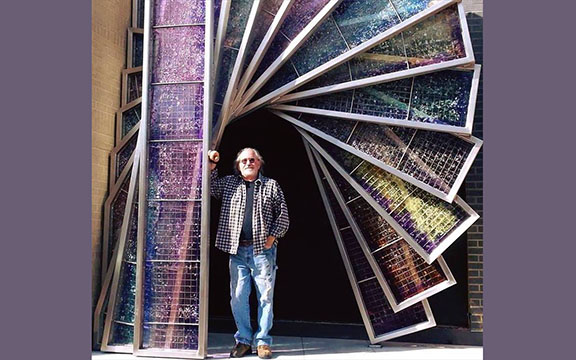
Photo: The artist at the installation of his sculpture “The Dance.”
Alan Asangan Binstock was born in 1948 and raised in Bronx, New York. His formal fine arts education began in New York’s High School of Music and Art, followed by undergraduate studies at Hunter College. He moved to Boulder, Colorado and began developing sculpture and jewelry of wood, stone, silver and other materials. There, he became a student of Yoga and then a teacher, as well as director of the Integral Yoga Institute in Boulder. He later moved to Pomfret Connecticut where he lived at Satchidananda Ashram–Yogaville East. He passed away on October 29, 2024 due to an inoperable heart condition.
Asangan first encountered Sri Swami Satchidananda (Gurudev) in the early 1970s, a meeting that would forever alter the course of his life. As a budding artist with a degree in architecture, he found in Gurudev’s teachings not just a spiritual path, but a purpose to infuse spirituality into the material world. Asangan’s humility and innate creativity led Gurudev to give him the name “Asangan,” which means “without attachment” in Sanskrit—a fitting tribute to someone who strived to live beyond the confines of ego and poured his soul into service for the Ashram in the early years of the Connecticut Ashram and whenever he was called upon to do so thereafter.
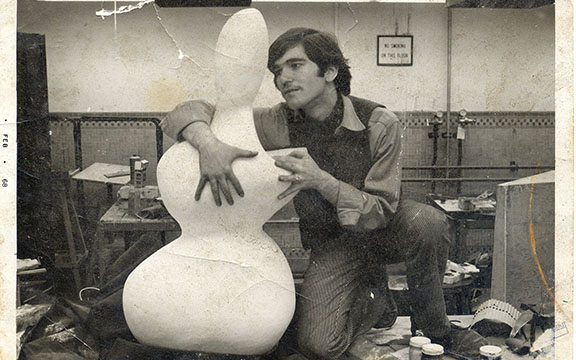
Working on a sculpture at Hunter College, 1968.
Asangan’s stories of his interactions with Gurudev are legend. A sample awaits you at the end of this tribute. For more than fifty years Asangan was a dedicated member of the Integral Yoga sangha (spiritual community). As a sangha member, his life was a testament to dedication, artistry, and a life guided by the principles of Integral Yoga as imparted by his Guru. Asangan’s life was not just one of architectural achievements or personal accomplishments; it was a life of devotion and love, a journey of manifesting Gurudev’s vision into reality and sculpting sacred spaces for countless seekers.

Photo of the Integral Yoga Yantra pendant.
One of his earliest and most notable contributions was creating a mold that would become the template for the original Integral Yoga Yantra pendant that so many sangha members wore over the years and still wear today. Asangan worked closely with Gurudev to be sure that the final wax mold was correct before any castings were done.
Another major contribution was working on early concepts for the Light Of Truth Universal Shrine (LOTUS). Asangan again worked closely with Gurudev to develop the first conceptual models for the structure that would become the LOTUS. Day and night Asangan worked from an original sketch by Gurudev. During meetings with Gurudev, Asangan helped develop Gurudev’s concept for the shape of the structure. Asangan created a model of what became the glulam beams and the lotus-shaped petals. This model can still be seen in the LOTUS Display Hall, along with a piece of Asangan’s original artwork that he donated to the LOTUS.
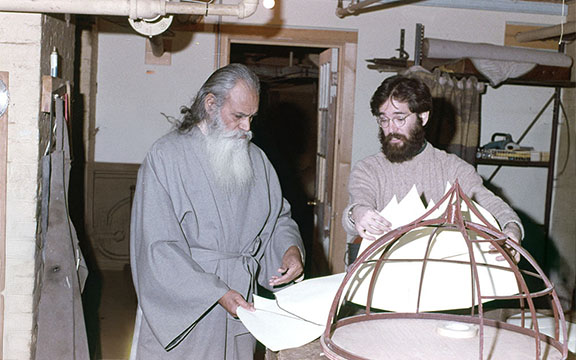
Photo: Asangan working with Gurudev on a LOTUS model, Yogaville East, 1980.
It was no surprise that Gurudev encouraged Asangan’s design talents leading him to pursue a career as an architect. After the Ashram moved from Connecticut to Virginia, Asangan and his beloved wife Karuna, moved to Maryland, where he studied and then earned a graduate degree in architecture from the University of Maryland, and she worked in the social justice/nonprofit sector. The couple often visited the Virginia Ashram and eventually purchased property there in the Yogaville community with an eye to building a home upon retirement. Even, while working full-time, Asangan continually made himself available for whatever service Gurudev had in mind.
Gurudev asked Asangan to design a building that would become the monastery for the Integral Yoga monastics. Gurudev also requested that Asangan design Guru Bhavan, the Ashram’s meditation hall, a place that has since become a haven for practitioners. With his architectural vision and love for Yogaville, Asangan designed spaces that would cradle the quietude and peace cherished by every seeker. His designs weren’t merely about structural beauty but the creation of sanctuaries, spaces where silence and stillness could blossom.
Through every project, whether large or small, Asangan was guided by his connection with Gurudev. And, most probably if asked which project was most dear to Asangan’s heart, it would not be a surprise if he had replied, “the Meru at Chidambaram.” After the Mahasamadhi of Sri Gurudev in 2002, his body was entombed in the Mahasamadhi Shrine named as “Chidambaram.” Later, a plan was developed to clad the walls in the Guha (lower portion of the building where the body rests) in white marble and connect the Guha with the upper level meditation hall. Asangan designed a magnificent large white marble meru in the shape of a lotus flower that was fabricated in India upon which the connecting piece rests.
Asangan and his beloved wife, Karuna had an unbreakable bond grounded in love, dedication, and a shared spiritual path. For forty-five years, they walked side by side on this spiritual path, inspiring one another and all those around them. Karuna, too, was an integral part of the Ashram’s history. As the first teacher for the new pre-school (which later developed into the Integral Yoga School and then into the Yogaville Vidyalayam) at the Connecticut Ashram, she brought the spirit of Gurudev’s teachings to her young students, instilling values that shaped their hearts and minds. And she continues to carry that spirit forward in her life.
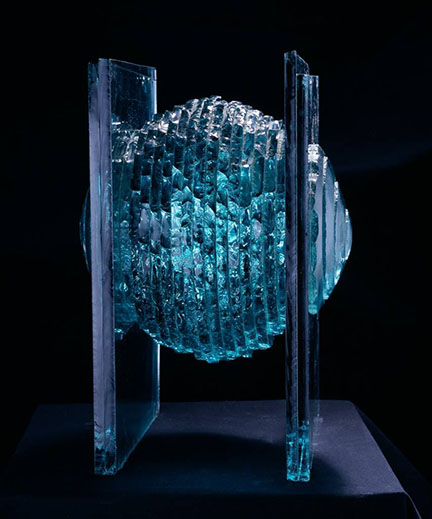
Photo of “Orb” by Asangan.
After years of dedicated service at the Ashrams and an influential career as a master architect for NASA, Asangan returned to his truest calling: sculpting. For over two decades, he exhibited his sculptures, with numerous solo shows in galleries from New York to Florida. His work has received critical national acclaim from Sculpture magazine, The Washington Post, and National Public Radio. He was commissioned to create large sculptures for spaces including a Maryland library, the Hyattsville Community Development Corp., among others.
Asangan’s work transcended traditional structures; he became a sculptor of light itself, creating radiant works from stone, glass, and steel that celebrated the interconnectedness of all beings. Each piece reflected his reverence for light as a symbol of divine wisdom and universal love. His art was, in every way, a continuation of his devotion, a visual prayer that invited viewers into the sacred.
When he was asked about his artistic process and goal he noted: “I investigate forms that express the nature of the seeker’s inner passage while capturing the wonder of the explorer’s outward search to find meaning in the universe. My goal is to catalyze a sense of excited inquiry and quietude, and hopefully, a moment of self-reflection.”
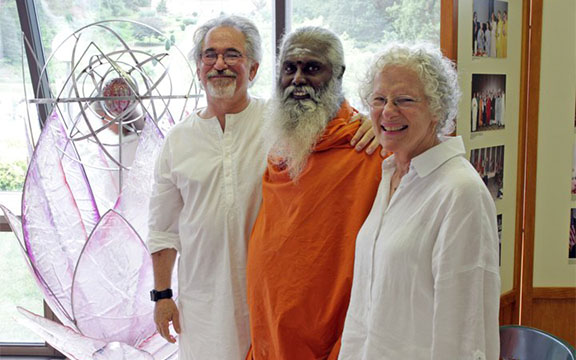
Photo: Asangan, Swami Maruthachalam, and Karuna, during unveiling of Asangan’s lotus sculpture at the LOTUS.
Asangan’s sculptures are characterized by shimmering light and celestial harmony that speak a language of peace and unity. These creations are more than art; they are meditative experiences, intended to awaken the divine light within every viewer. His workshop became a temple of sorts, a place where he meditated through his craft, guided by the essence of Gurudev’s teachings and his own deep spiritual connection. Asangan and Karuna moved to Yogaville after completing their dream retirement home that he designed. There, he set up a massive workshop to continue creating his artwork.
And, as always, Asangan continued lending his talents to projects like the restoration of an original sculpture of Gurudev from the 1970s and providing assistance and workshop space for the restoration of the life-size portrait of Sri Swami Sivananda that adorns Sivananda Hall. Most recently, he began serving the Ashram and Integral Yoga International as chairman of the Board of Trustees for the organization.
Through his enduring service, Asangan lives on in the hearts of those he touched. His artistry, humility, and tireless dedication remain etched into the walls of Satchidananda Ashram and the hearts of Integral Yogis worldwide. May his example continue to inspire us to live with devotion, dedication, and a higher purpose. As sangha member Buffy Meera Stewart beautifully noted, “He is now in the Sea of Grace, where we all will meet again!”
“A Seat for the Guru: Humor, Humility, and Lessons Learned” by Asangan Binstock
At Colorado University (in 1972 or ’73), we were hosting a talk for Gurudev. Just as the talk was about to begin, Gurudev unexpectedly turned to me and said, “Asangan, come up and introduce me.” I was completely caught off guard. “Introduce you?” I panicked. I managed a smile that hopefully hid my anxiety, but inside, I was in full-blown panic. What was I supposed to say?
So, I walked up to the stage with him, waited until he took his seat, grabbed the mic, looked around, and tried my best to mask what I didn’t know. I started with, “Thank you all for coming,” hoping that filling the time with a bit of gratitude would help. “It’s wonderful that we can all be here together. I’d like to introduce my teacher, Sri Swami Satchidananda.” I turned, bowed with my hands in Namaste to him, and quickly exited the stage. Gurudev took the mic, looked at me with a warm smile, and said, “Well, let me add a little bit.” And he did his own introduction because I’d clearly dropped the ball.
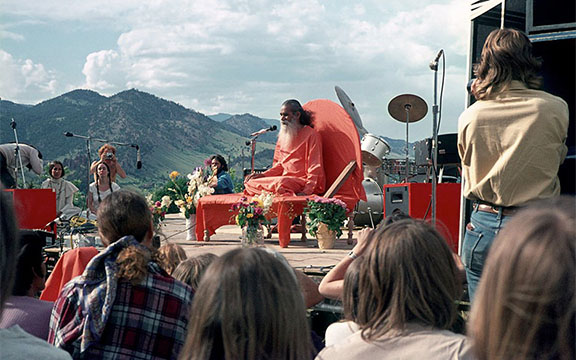
Photo: “The Chair,” Boulder, Colorado, early 1970s.
It’s amazing that he kept giving me the ball, even though I had absolutely nothing to offer in that moment. To add to my embarrassment, Tattwan and I had this idea: “It’s crazy to lug that big chair around everywhere Gurudev speaks.” So, we decided to make him a chair ourselves. It was two pieces of plywood connected by a piano hinge so it could fold, with legs that screwed in, like those on a coffee table. Looking back, the whole thing seems ridiculous, but we thought it was a great idea at the time.
To top it off, we decided, “We can’t sit on it to test it—that’s the Guru’s chair.” So, without any trial, we just got the cushions made and called it done.
So there it was: a good-looking chair that really didn’t seem sturdy enough to hold even a bowl of fruit. Gurudev came out for the talk, thanked us, turned to thank the audience, and then looked at the chair. After a moment’s hesitation, he sat down. I think that was my second “burn mark” on the forehead.
Miraculously, he managed to sit without incident—what I might call my first experience of witnessing a miracle. Because, later, when I tried sitting in it, one of the legs snapped off, tearing the plywood. It was an utterly useless chair. Lessons were learned. At least, if we didn’t fully learn them, we didn’t repeat that mistake. We certainly had a wonderful time along the way.
And in his own kind way, Gurudev enjoyed having a little fun with us too. Once, when I went to pick him up for a talk, I knocked on the door, expecting his secretary to answer. Instead, Gurudev himself opened it. He stood there, filling the doorway, his hair sticking out in every direction. I’d heard someone mention that he oiled his hair, but this was something else altogether. I was a bit startled, to say the least, and he, of course, burst out laughing. He had a great time with it all.
(Find more of Asangan’s stories here)

